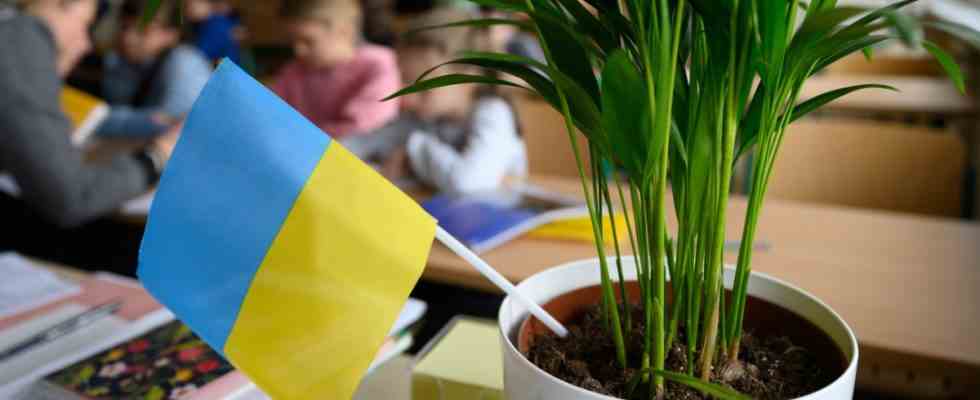They may have been violently torn from their old lives, but in many places the arrival at schools in Bavaria was made easy for the Ukrainian refugee children. There were welcome groups at his grammar school and the 40 or so Russian-speaking students looked after the newcomers very intensively, says Martin Pfeifenberger, headmaster at the Helene-Lange-Gymnasium in Fürth. The students led the newcomers through the school building and helped with registration and bureaucracy. “It worked incredibly well,” says the director – and then adds a big regret: Unfortunately, this first good contact has since broken off in many cases.
Since the summer of 2022, older Ukrainian students have been officially learning in bridging classes across Bavaria. German, English and math are on the curriculum there. integration rather not. Several speakers came to this conclusion at an expert hearing by the Committee for Education and Culture on Thursday in the state parliament. “Our bridging class is a satellite in the school building and that’s not good,” says Rainer Lacler, headmaster at the Willi Ulfig Middle School in Regensburg. His school also had a welcome group at first. That turned out to be an “achievable task”. Looking back, some of the students would have learned better there than in the current bridge classes.
Most speakers agree that the problem with bridge classes is the extremely large range of different students who are taught there. Eleven-year-olds study there together with 17-year-olds; Children with special needs next to candidates for high school, ambitious next to those who refuse to learn. At the same time, the bridging classes have a relatively extensive program of their own, lessons in the normal classes with German children are only provided on an hourly basis. “Progress in language acquisition is extremely slow,” says Principal Lacler. Some of the students simply do not want to learn German. He sees an attitude of protest against their mothers’ decision to flee. Some children did not want to flee and long for old friends, their father and grandparents.
What is the best way to school refugee children? The question has been discussed with renewed urgency since the beginning of the war in Ukraine. German schools have now accepted more than 200,000 Ukrainian students, and there are 30,000 in Bavaria. They should be integrated quickly. But how? The federal states are going different ways: Some put the students directly into the regular cash registers and offer German courses at the same time. Others, such as Berlin, created their own classes for the new arrivals, in which they were supposed to learn German in a safe environment. Bavaria is trying to find a middle way: Minister of Education Michael Piazolo (FW) ordered elementary school children to have a “language bath” in normal elementary school classes. Bridging classes were set up for the older studentswhich are to be continued in the coming year.
The fact that they were initially taken care of in a native-speaker group was a blessing for many children, says Guido Terlinden, who offers special psycho-trauma therapy for children and young people at the Refugio Munich counseling center. After the stress or trauma of fleeing, a structured everyday life, contacts with other children and leisure activities are the most important things. More children with emotional stress and behavioral problems have recently come to his consultation hours from elementary schools where there are no longer any bridging classes. There were also elementary school teachers who tried to tame the Ukrainian children and felt quite alone with it.
“But children learn German above all from other children”
Some of these students suffered from the experiences of fleeing. But others were overwhelmed by the task of adapting to a new school system in an unfamiliar language, explains Terlinden. Often the students also had to take part in online lessons in Ukrainian in the afternoon.
The bridge classes with their own compatriots, on the other hand, gave the children a feeling of security. Nevertheless, even the psychotherapist Terlinden doesn’t think much of it in the long run. The students have too little contact with Germans. “Children learn German above all from other children,” he said. This is also confirmed by the invited scientist, Magdalena Michalak, Professor for Didactics of German as a Second Language at the University of Erlangen-Nuremberg. Learning German doesn’t work by cramming grammar, but through shared experiences with Germans, for example in a sports club, she said. At worst, separate classes could even lead to a parallel culture, she warned.
According to the experts, bridge classes can only be a start. The way into German society leads through the normal school system. According to an initial forecast, 40 percent of the pupils in bridge classes in Nuremberg could transfer to middle school in autumn, says Thomas Reichert, technical director of the Nuremberg State Education Authority. Another ten percent could make it to the Realschule or the Gymnasium. “We’re on our way,” he says. Even in regular school, however, these children cannot be left to their own devices. They need massive support and remedial classes, says Reichert.

